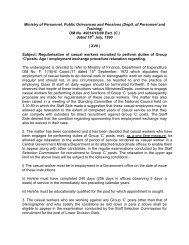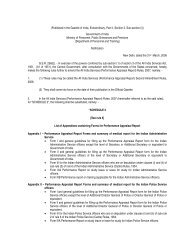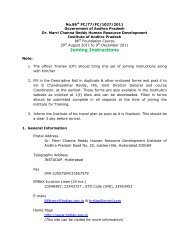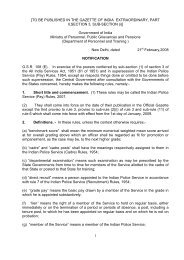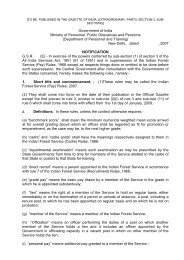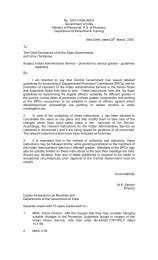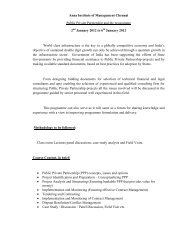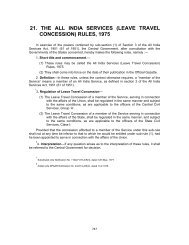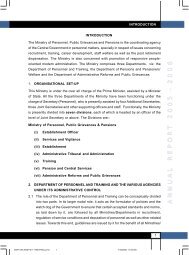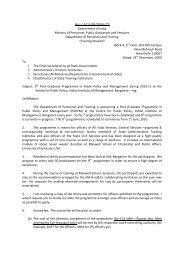UNIFORM - Ministry of Personnel, Public Grievances and Pensions
UNIFORM - Ministry of Personnel, Public Grievances and Pensions
UNIFORM - Ministry of Personnel, Public Grievances and Pensions
You also want an ePaper? Increase the reach of your titles
YUMPU automatically turns print PDFs into web optimized ePapers that Google loves.
4A. Kit Maintenance Allowance - Every member <strong>of</strong> the Service shall be entitledto receive from Government a Kit Maintenance Allowance <strong>of</strong> 5 one hundred <strong>and</strong> fiftyrupees per month 6 [ ].5. Grant for horse <strong>and</strong> saddlery:-5(1) Every member <strong>of</strong> the Service on appointment thereto <strong>and</strong> at each interval <strong>of</strong>seven years thereafter shall, if the Government considers that he should maintain or, asthe case may be, continue to maintain a horse, be entitled to receive a grant notexceeding one thous<strong>and</strong> <strong>and</strong> two hundred rupees towards the cost <strong>of</strong> the horse <strong>and</strong>saddlery:Provided that-(a) no such grant shall be renewed unless the member <strong>of</strong> the Service certifiesthat he maintains <strong>and</strong> has ordinarily maintained a horse for the past sevenyears;(b) the Government may withhold any such grant from a member <strong>of</strong> the Servicewho is due to retire within five years <strong>of</strong> the date when the grant is due.5(2) The size <strong>of</strong> the horse maintained shall not be less than 14.2 h<strong>and</strong>s in height:7 Provided that a member <strong>of</strong> the Service when posted to a hill district maymaintain a hill pony.5(3) No member <strong>of</strong> the Service, who has received the grant under sub-rule (i),shall without the previous permission <strong>of</strong> the Govt. part with the possession <strong>of</strong> sell orpledge the horse.5(4) Every member <strong>of</strong> the Service who maintains a horse from the grant receivedunder sub-rule (i) , shall have the horse insured at his own cost.8 5A. Omitted6. Modifications in the working dress - The Central Government afterconsultation with the State Government concerned, may, from time to time, make suchmodification in the working dress which a member <strong>of</strong> the Service may wear whileengaged in work <strong>of</strong> an informal character as local circumstances may require.9 7. Interpretation - If any question arises as to the interpretation <strong>of</strong> these Rules,the Central Government shall decide the same.8. Repeal <strong>and</strong> Saving - Any rules corresponding to these rules in forceimmediately before the commencement <strong>of</strong> these rules are hereby repealed;5Amended vide DP&T Notification No. 11058/2/98-AIS (III) dated 27.11.1998 vide GSR No.244 dt.19.12.19986Deleted vide DP&T Notification No. 11058/1/97-AIS(III) dated 24.09.1998 vide GSR No.194 dt. 10.10.19987Introduced vide MHA Notification No. 4/6/58-AIS (III) dated 28.08.19588Omitted vide DPAR Notification No. 11058/3/74-AIS (III) dated 11.02.19769Substituted vide DP&AR Notification No. 7/1/73-AIS (III) dated 04.01.1975
Provided that any order made or action taken under the rules so repealed shallbe deemed to have been made or taken under the corresponding provision <strong>of</strong> theserules.SCHEDULE10 1 Review Order:- When <strong>of</strong>ficers are on mounted duty, this consists <strong>of</strong> peckcap, jacket, whistle <strong>and</strong> lanyards, breeches, field boots 11 (optional), spurs (optional)khaki shirts, blue tie, khaki socks, Sam Browne belt <strong>and</strong> sword, medals <strong>and</strong> decorations.These shall be worn on all state ceremonies (e.g. public arrivals <strong>and</strong> departure <strong>of</strong>President, or the Governor, presentation <strong>of</strong> Guards <strong>of</strong> honour or such occasions) atceremonial parades or whenever full dress is ordered.When <strong>of</strong>ficers are not on mounted duty, this consists <strong>of</strong>:-Type (A) - Peak Cap. Jacket (gabardine or drill), whistle <strong>and</strong> lanyard slacks <strong>of</strong>the same material as the jackets, brown, ankle-boot/shoes, khaki shirts,blue tie, khaki socks, Sam Browne belt <strong>and</strong> sword, medals <strong>and</strong>decorations.Type (B) -Peak cap, shirt (khaki cellular), slacks 11 Khaki drill or cotton terene orkhaki gabardine cotton, Khaki socks, shoes Sam Browne belt <strong>and</strong>sword, whistle, lanyard <strong>and</strong> ribbons, medals <strong>and</strong> decorations.Note - The type <strong>of</strong> Review Order to be worn on any occasions may be prescribedby the 11 Director General <strong>and</strong> Inspector General <strong>of</strong> Police/InspectorGeneral <strong>of</strong> Police, as the case may be, in charge <strong>of</strong> the State Police orDirector General/Inspector General, as the case may be, in charge <strong>of</strong> theforce.2. Working Dress--Type (1).- Peak cap, 11 jacket, slacks <strong>of</strong> the same material as the jacket 11(gabardine or drill or khaki gabardine cotton), whistle <strong>and</strong> lanyard,shoes/ankle boots, khaki socks, khaki shirt, blue tie, cloth belt <strong>of</strong> thesame material as the jacket or Sam Browne belt, <strong>and</strong> ribbons.Type (2).- Peak cap, bush shirts with cloth belt, slacks, socks <strong>and</strong> 11 shoes/ankleboots,whistle, lanyard <strong>and</strong> ribbons.Type (3).- Peak cap, shirts with Sam Brown belt (with or without jersey) or Webbelt, slacks, socks, 11 shoes/ankle-boots, whistle, lanyard <strong>and</strong> ribbons.Type (4).- Peak cap, shirts (angola or cellular), Web belt (with or without jersey),slacks (gabardine or drill),, Socks <strong>and</strong> shoes/ankle-boots/jungle boots.Note:-The type <strong>of</strong> Working Dress to be worn may be decided by the 12 DirectorGeneral <strong>and</strong> Inspector General <strong>of</strong> Police/Inspector General <strong>of</strong> Police, asthe case may be, in charge <strong>of</strong> the State Police or "director10Substituted vide MHA Notification No. 7/6/68-AIS (III) dated 23.06.196911Inserted substituted vide DP&AR Notification No. 7/2/69-AIS (III) dated 28.12.197012Substituted/inserted/deleted vide Notification No. 11058/1/82-AIS (III) dated 01.10.1982
12 [ ]General/Inspector General, as the case may be, in charge <strong>of</strong> the Force,"shall be substituted;13 3-A. Mess Dress - This shall be worn at messes, at <strong>of</strong>ficial publicentertainment, or when invited to meet the President or Governor at dinner or at an<strong>of</strong>ficial function, formal or ceremonial occasions, unless Review Order is specificallyordered.It shall consist <strong>of</strong>:-(a) Black short buttoned up coat with black trousers or white trousers or whiteshorts buttoned upcoat with white trousers or black trousers.(b) Medals - Miniatures will be worn for Mess functions the bottom edge <strong>of</strong>the bar to touch the top edge <strong>of</strong> the left breast pocket. For State functionsfull size medals will be worn.(c) Foot wear - Plain black leather Oxford shoes with plain toe caps with fivepairs <strong>of</strong> eye-lets.4. Head Dress - Peak cap, khaki gabardine [whenever khaki is mentioned theshade will be spinners Vigah No. (1) 4 1/2 total depth, diameter across the top 10-3-/8"for a cap fitting 21-3/4" in circumference the top to be 1/8" larger or smaller in diameterfor every 1/4" by which the cap may vary in size <strong>of</strong> head above or below the beforementioned st<strong>and</strong>ard, e.g. for a cap 22-1/4" in circumference, the diameter across the topto be 10-5/8" <strong>and</strong> for a cap 21" in circumference, the diameter to be 10". The sides to bemade in our pieces <strong>and</strong> to be 2-1/8" deep between the wealts Indian Police Servicepattern badges <strong>of</strong> silver metal to be worn in the centre <strong>of</strong> the b<strong>and</strong> in front. The cap to beset up on a b<strong>and</strong> <strong>of</strong> stiff leather or other material 1 3/4 deep. Chin strap <strong>of</strong> brown leather3/8" wide buttoned on two gorget buttons <strong>of</strong> the Indian Police Service pattern placedimmediately behind the corners <strong>of</strong> the peak.As an alternative to the peak cap, <strong>of</strong>ficers may wear pagri <strong>of</strong> 14 khaki silk or muslinor Beret cap <strong>of</strong> 15 Navy blue colour. <strong>of</strong>ficers <strong>of</strong> the rank <strong>of</strong> D.I.G. <strong>and</strong> above will war adark blue bank with the badge appropriate to their rank.The Director, Intelligence Bureau, Government <strong>of</strong> India "Directors General <strong>and</strong>Inspectors General <strong>of</strong> Police;" inspectors General <strong>of</strong> Police, Deputy Directors,Intelligence Bureau, Commissioners <strong>of</strong> Police, Deputy Inspector General <strong>of</strong> Police,Deputy Commissioners <strong>of</strong> Police Superintendent <strong>of</strong> Police who are entitled to wear theState Emblem <strong>and</strong> two stars, will wear a dark blue b<strong>and</strong> <strong>of</strong> woolen material to be placedbetween the two lower wealts with silver embroidered Indian Police Service crest, Chainstrap <strong>of</strong> brown leather. Officers <strong>of</strong> the rank entitled to wear a blue b<strong>and</strong> <strong>and</strong> embroideredcrest on their peak caps will, if wearing pagri, wear a similar blue b<strong>and</strong> embroideredcrest on the pagri.13Substituted vide DP&AR Notification No. 11058/3/76-AIS (III) dated 08.07.197714Added/substituted vide MHA Notification No.7/6/68-AIS-III dated 23.06.196915Substituted vide DOP&T Notification No.11058/1/90-AIS-III dated 22.08.1990
5. 16 Jacket - Khaki drill/gabardine, cotton or cotton terene (during hot weather)<strong>and</strong> khaki gabardine woollen or woolen terene (during cold weather) single breasted cutas lounge coat to the waist, very loose at the chest <strong>and</strong> shoulders but fitted at the waist,military skirt to bottom edge. A silver plated hook on each side at the waist. length as inordinary civilian lounge coat i.e., covering the seat. Collar to be cut as in an ordinarycivilian lounge coat. Two cross path breast pockets above 6 1/2" wide <strong>and</strong> 7 1/2 deep tothe top <strong>of</strong> the flap with a 2-1/4" box pleat in the centre fastened at the top with a smallIndian Police Service pattern button flap, with button hole to cover pocket 2-1/4" deep<strong>and</strong> 6 1/2" wide. Two exp<strong>and</strong>ing pocket, fastened at the top with a small Indian PoliceService pattern button; flap, with button hole to cover pockets, 3 1/2" deep <strong>and</strong> 10 3/4"wide the top <strong>of</strong> the pocket to be tacked down at the corners in such a manner thatpocket can be exp<strong>and</strong>ed at the top also is necessary. Four medium Indian PoliceService pattern buttons down the front. The buttons should be so fixed that the bottommostbutton covers the navel <strong>and</strong> the top-most button fixed one-third distance betweenthe navel <strong>and</strong> the position <strong>of</strong> the tie-knot. Pointedcuffs, 5" high at the point <strong>and</strong> 2 1/2"behind. Shoulder straps <strong>of</strong> the same material as the garment fastened with a smallIndian Police Service pattern button. The jacket to be worn with a s<strong>of</strong>t or semi-stiff collar<strong>and</strong> shirt <strong>and</strong> dark blue sailor.6. Trousers (Slacks) - Khaki drill/gaberdine, cotton terene or khaki gabardinewollen or wollen terene 17 [ ] to match jacket without turn-ups <strong>and</strong> shaped from instep toheels-the bottom to measure 16 to 18 inches.7. 18 Breeches 19 (Bedford or Jodhpur Type):- Khaki cotton cord to be worn.8. Boots, Ankle - Ankle, plain brown leather with plain toe-caps <strong>and</strong> 20 seven ornine pairs <strong>of</strong> eye-lets.9. Shoes:- Plain brown leather Oxford shoes with plain toe-caps <strong>and</strong> 5 pairs <strong>of</strong>eye-lets.10. Boots, Field - Brown leather, s<strong>of</strong>t legs stiffened to a depth <strong>of</strong> 4 to 6 inchesfrom the top, laced at the instep, with nine pairs <strong>of</strong> eye-let holes, brown leather garters;no gusset at the top <strong>of</strong> the leg <strong>and</strong> no toe-caps. Once strap held by a loop at the backtop to keep the boot in position.11. Spurs (optional-for mounted duty only):- Light hunting, with brown leatherstraps <strong>and</strong> shields <strong>and</strong> brown leather understraps.12. Belts - Sam Brown <strong>of</strong> Army Regulation pattern but with silver mountings orweb belt. Cloth belt <strong>of</strong> the same material as the jacket with silver mountings may beworm with the working dress when revolver is not carried.13. Sword- Infantry pattern with half basket built in white metal <strong>and</strong> device"I.P.S." <strong>and</strong> State Emblem.14. Sword Knot - Brown leather with acorn.16Substituted vide DP&T Notification No. 7/2/69-AIS (III) dated 28.12.197017The words “or Khaki drill” deleted vide MHA Notification No. 6/4/65-AIS (III) dated 11.07.196718Amended vide MHA Notification No. 6/5/63-AIS (I) dated 22.11.196519Substituted/added vide MHA Notification No.7/6/68-AIS-III dated 23.06.196920Modified vide DP&AR Notification No. 11058/11/77-AIS (III) dated 13.10.1977
15. Seabbard - brown leather, infantry pattern.16. Whistle - Of the police pattern, to be worn attached to a dark blue roundplaited lanyard <strong>and</strong> carried in the left breast pocket.17. Badges <strong>of</strong> Rank - Silver metal. The State Emblem to be 5/32" by 3/4". Thestars to be <strong>of</strong> the "Star <strong>of</strong> India" (five pointed) pattern <strong>and</strong> 1" broad. The DeputyDirectors, Intelligence Bureau, Commissioners <strong>of</strong> Police <strong>and</strong> Deputy Inspectors General<strong>of</strong> Police shall wear the three stars in the badges <strong>of</strong> their rank on the shoulder strap inthe form <strong>of</strong> an equilateral triangle with apex upwards. The Strap should be slightlyfrosted but without any design in the centre. The crossed sword <strong>and</strong> baton will be wornso that the point <strong>of</strong> the sword is to the front, <strong>and</strong> the edge <strong>of</strong> the blade outwards ortowards the arm. The sword should measure 7/8" <strong>and</strong> the baton 1-3/4".Embroidered badges <strong>of</strong> rank, worked in dark blue silk thread may be worn whenwearing informal working dress, at the time <strong>of</strong> riots, dacoit operation <strong>and</strong> such otherduties.21 (a) Director, Intelligence Bureau Crossed sword <strong>and</strong> baton <strong>and</strong> theState Emblem <strong>and</strong> one star.(b) (i) Director Central Bureau <strong>of</strong> Investigation(ii) Director General, Central Reserve Police(iii) Director, General, Border Security Force(iv) Director General, Security(v) Director General <strong>and</strong> Inspector General <strong>of</strong>Police in the States <strong>of</strong> Andhra Pradesh,Assam, Bihar, Gujarat, Jammu & Kashmir,Himachal Pradesh, Karnataka, Kerala,Maharashtra, Madhya Pradesh, Orissa,Punjab, Rajasthan, Tamil Nadu, UttarPradesh <strong>and</strong> West Bengal.(c)(i) 22 Inspectors General <strong>of</strong> Police in the States,Union Territory <strong>of</strong> Mizoram <strong>and</strong>Commissioner <strong>of</strong> Police, Delhi.(ii) Additional Inspector General Bureau(iii) Joint Director, Intelligence Bureau(iv) Additional Director/Joint Director, CentralBureau <strong>of</strong> InvestigationDittoDittoDittoDittoDittoCrossed sword <strong>and</strong> baton <strong>and</strong> onestarDittoDittoDitto21Substituted vide MHA Notification No. 7/8/68-AIS.III dated 05.06.196922Modified vide DP&T Notification No. 13/1/73-AIS.III dated 20.01.1975
(v) Comm<strong>and</strong>ant, Central Forensic Institute(vi) Director, National Police Academy(vii) Inspector, General Border Security Force/Central Industrial Security Force/CentralReserve Police(viii) Special Inspector General Indo-TibetanBorder Police(d)(i) 22 All other <strong>of</strong>ficers drawing pay above thetime scale including Selection Grade(ii) 22 Inspector General <strong>of</strong> Police <strong>of</strong> all the UnionTerritories other than 23 Mizoram(e) 23 (i) Superintendent <strong>of</strong> Police in the selectiongrade(ii) All <strong>of</strong>ficers drawing pay in the Senior timescale who have put in 15 years service <strong>and</strong>above(f)(i) District Superintendent <strong>of</strong> Police(ii) Comm<strong>and</strong>ant <strong>of</strong> a Battalion(iii) All <strong>of</strong>ficers drawing pay in the senior timescale who have more than 10 years' service<strong>and</strong> less than 15 years' service(g) All <strong>of</strong>ficers [other than those mentioned in (f) (i)& (ii) above] drawing pay in the senior timescalewho have 10 years' service <strong>and</strong> less(h) Assistant Superintendent <strong>of</strong> Police in charge <strong>of</strong>a sub-division or holding any post certified tobe <strong>of</strong> equivalent status or who have 5 years'service <strong>and</strong> above(i) Assistant Superintendent <strong>of</strong> Police with 2 years’service or more but less than 5 years’ <strong>and</strong> (a)not in charge <strong>of</strong> a sub-division or (b) notholding post <strong>of</strong> equivalent rank referred to in(h) above(j) Assistant Superintendent <strong>of</strong> Police with lessthan 2 years' serviceDittoDittoDittoDittoThe State Emblem <strong>and</strong> three starsDittoThe State Emblem <strong>and</strong> two starsDittoThe State Emblem <strong>and</strong> one starDittoDittoThe State EmblemThree starsTwo starsOne star(NOTE - The term `service' refers to year <strong>of</strong> allotment)23Substituted/inserted vide DP&AR Notification No. 11058/1/82-AIS.III dated 01.10.1982
18. Length <strong>of</strong> service in clause (d) to (h) denotes the length <strong>of</strong> service (actual orassumed) in the Service. In the case <strong>of</strong> direct recruits selected on the results <strong>of</strong>competitive examinations, the term means actual length <strong>of</strong> service in the Service. Inother cases i.e., war service recruits, emergency recruits or <strong>of</strong>ficers promoted to theService, the term refers to the assumed length <strong>of</strong> service in the Service <strong>and</strong> will,therefore, exceed the actual length <strong>of</strong> service in the Service by the period for whichcredit is given to the <strong>of</strong>ficers for purposes <strong>of</strong> seniority in the Service.19. Where the grant <strong>of</strong> any badge <strong>of</strong> rank is dependent on the passing <strong>of</strong> anefficiency bar, the <strong>of</strong>ficers must have passed that bar.20. The badges <strong>of</strong> rank to be worn by an <strong>of</strong>ficer should be related to the rank thathe actually occupies either substantively or in an <strong>of</strong>ficiating capacity in a police post. Inthe case <strong>of</strong> an Indian Police Service Officer who is on deputation to a non-police post,the badge or rank to be worn by him should be related to the rank <strong>of</strong> the post which heoccupied substantively or in an <strong>of</strong>ficiating capacity in his own State immediately prior tosuch deputation; while in the case <strong>of</strong> an Indian Police Service <strong>of</strong>ficer who is ondeputation to a higher police post outside the State, he should be allowed to wear thebadge <strong>of</strong> rank <strong>of</strong> the higher post even while he visits his own State on <strong>of</strong>ficial duty orotherwise.21. Members <strong>of</strong> the Indian Police Service shall wear a silver departmental badgeI.P.S. in half inch block letters at the base <strong>of</strong> the shoulder strap.22. Belt- Second shoulder strap to the Sam Browne belt. To be worn whenrevolver is carried on the right side.23. Revolver or (at option <strong>of</strong> each <strong>of</strong>ficer) an automatic pistol – With brownholster <strong>and</strong> ammunition pouch <strong>of</strong> leather.(The revolver <strong>and</strong> ammunition pouch shall not be worn with Review Order unlessspecific orders to that effect are issued).24 24. Helmet (for informal working dress).- Army khaki tent club pattern, with apagri or six- folds <strong>of</strong> khaki with a dark blue flash, a quarter <strong>of</strong> an inch wide at the topbetween the helmet <strong>and</strong> the pagri, the whole when tied not to exceed three inches inwidth. No metal fittings. Brown leather straps 3/8" wide.25. Bush Shirts.- Infantry pattern, <strong>of</strong> khaki drill, cellulur <strong>of</strong> twill, with khaki bonebuttons, the size <strong>and</strong> shape <strong>of</strong> which shall be the same as those prescribed for theinfantry pattern <strong>of</strong> bush shirt <strong>and</strong> will have:-(a)25 two breast pockets 6 1/2"X5 1/2" with three point flaps (fastened by onebutton) with a centre pleat 1 1/2" wide, flap being 5 1/2" long by 2 1/2" deep;(b) two lower side inner pockets with slanting flap, 8" long, 2 1/2" deep <strong>and</strong> 1"backward slant.(c)full length sleeves with single cuffs each having one button;24Substituted vide MHA Notification No. 13/57/57-AIS.III dated 08.03.195825Amended vide MHA Notification No. 6/6/60-AIS.III dated 20.02.1961
(d)(e)(f)(g)(h)(i)plain back without pleats, with 1 vent at centre <strong>of</strong> back at bottom, 10" long;26 the shirt open all the way down the front with 5 buttons showing <strong>and</strong>fastened by button holes in a reinforced edge 1 1/2" wide, the top buttonbeing a dummy one;st<strong>and</strong> <strong>and</strong> fall collar cut in one piece, measuring 3-3/4" wide at the back <strong>and</strong>4" at the front, when finished;adjustable shoulder straps, which should be slipped on to the shoulderthrough a loop;loops at the side seams, to take a detachable belt; <strong>and</strong>length down to the level <strong>of</strong> the knuckles when the fistsare clenched <strong>and</strong> fullyextended downwards.26. Gorget patches - Officers wearing the State Emblem <strong>and</strong> two stars <strong>and</strong><strong>of</strong>ficers wearing the State Emblem <strong>and</strong> three stars, should wear gorget patches <strong>of</strong> darkblue woollen material with a central silver stripe; <strong>and</strong> Officers <strong>of</strong> higher ranks, shouldwear similar gorget patches with a silver oak-leaf pattern central stripe.27. Jersey - Khaki woollen with two buttons in front.28. Short.- Khaki drill with two cloth extended straps <strong>and</strong> side buckles waist b<strong>and</strong>2-1/4" to width.26 29. Shirts - Khaki, cotton-cellular or twill, cotton terene or angola with twobreast pockets <strong>of</strong> the jacket pattern with khaki bone buttons when worn under the jacket.All shirts should be <strong>of</strong> khaki popline.30. P.T. Vests - White cotton or woolen half sleeves for probationary <strong>of</strong>ficersunder training.31. Putties Ankle - Khaki woollen <strong>of</strong> the Fox's spiral pattern.32. Hose Tops - Khaki woollen.33. Socks - Khaki cotton or woollen or mercerised.34. Stockings - Khaki woollen.27 35. Overcoat (Optional) - Khaki drab mixture cloth; milled <strong>and</strong> water pro<strong>of</strong>double-breasted, to reach to the point <strong>of</strong> the knee, 18 to 29 inches slit at the back withsmall saddle flap. Turndown collar 2" deep, with lapel <strong>and</strong> step, fastening with one hook<strong>and</strong> eye. Four large buttons on each side, three to button <strong>and</strong> one under turn. Twobuttoned pockets with flap, one inside breast pocket at each side sword slit at left side,26Substituted vide DP Notification No. 7/2/69-AIS.III dated 28.12.197027The word optional added vide MHA Notification No. 6/5/63-AIS.III dated 22.11.1965
lose turnback cuffs <strong>of</strong> single material; 4 1/2" deep shoulder straps <strong>of</strong> the same materialas the garment fastened with small buttons. Badges <strong>of</strong> rank <strong>and</strong> buttons in silver metal.The collar to be provided with a cloth tape to button across the opening at the throatwhen required. The coat to be, lined with drab flannel. The cloth will be that specified forthe State in which the <strong>of</strong>ficer is serving.36. Gloves - Tan regulation pattern, to be worn, if necessary.37. Members <strong>of</strong> the Indian Police as defined in clause (c) <strong>of</strong> rule 2 <strong>of</strong> the IndianPolice Service (Recruitment) Rules, 1954, may continue to use the letters "I.P." instead<strong>of</strong> the letters "i.P.S." in the devices prescribed for the crest, badges <strong>and</strong> buttons.38. Special provisions for women <strong>of</strong>ficers:(a) Working Dress: This shall consist <strong>of</strong> same items as prescribed for male <strong>of</strong>ficerswith the following alterations in the specifications in respect <strong>of</strong> slacks <strong>and</strong>footwear:-I. Slacks :- Pleatless trousers <strong>of</strong> Khaki colour with two side pockets similar inpattern to those prescribed for the male <strong>of</strong>ficers with front flap closed <strong>and</strong> azip flap on the right side at a position under the arm, the front flap beingoptional.II. Shoes :- Derby brown leather shoes or plain brown leather shoes with heelsnot more than 1 1/2" measured from the base <strong>of</strong> the rear stitching <strong>of</strong> theuppers.III. Ankle Boots <strong>and</strong> Field Boots:- Of the same specifications as thoseprescribed for male <strong>of</strong>ficers, with heels not more than 1 1/2" measured fromthe base <strong>of</strong> the rear stitching <strong>of</strong> the uppers.(b) Mess Dress:- This shall consist <strong>of</strong>:-(i) Saree :- Cream-colour silk saree in winter <strong>and</strong> cotton or terry-cot saree <strong>of</strong>the same colour in summer, normal length with red Zari border <strong>of</strong> minimumwidth 3" <strong>and</strong> maximum width 5". The zari border may be either <strong>of</strong> goldplated silver thread or silk thread in a floral pattern.(ii) Blouse:- Colour matching with saree, air hostess sleeves. The saree beingdraped over the left (shoulder <strong>and</strong> anchored by an Indian Police Servicebadge chromed or in silver metal. The blouse would be <strong>of</strong> waist length withminimum <strong>of</strong> four buttons <strong>and</strong> the length <strong>of</strong> the blouse ending where thesaree begins, <strong>and</strong> without st<strong>and</strong> <strong>and</strong> fall collers, concealed hooks may beused instead <strong>of</strong> buttons in appropriate numbers, if desired.(iii) Footwear:- Cream coloured s<strong>and</strong>als/shoes with straps <strong>and</strong> covered toes;heels not exceeding 2 1/2".(iv) Medals- May be worn on the saree over the left breast.(c) P.T. Kit:- It shall consist <strong>of</strong> :-
(i) Shorts/white track pants (white with police blue stripes).(ii) High-collered white `T' Shirts with Indian Police Service colours with 3buttons in the front.(iii) White socks with appropriate footwear as prescribed for male <strong>of</strong>ficers.(d) Cosmetics:- No cosmetics shall be used by lady <strong>of</strong>ficers except a `bindi' on theforehead <strong>and</strong> `sindur' filling in the head parting <strong>and</strong> special cream which does notleave a shade on the skin <strong>and</strong> which otherwise suited may be used according tothe requirement <strong>of</strong> the weather. Both `bindi' <strong>and</strong> `sindur' shall be asinconspicuous as possible.(e) Ornaments:- Women <strong>of</strong>ficers may wear `Mangal sutra' wedding rings <strong>and</strong> earstuds.But these shall be as inconspicuous as possible. No other ornamentsshould be worn by lady <strong>of</strong>ficers when in uniform.39. Alternative uniform for lady <strong>of</strong>ficers in advanced stage <strong>of</strong> pregnancy:-Lady <strong>of</strong>ficers with about 16 weeks <strong>of</strong> pregnancy may switch-over to the followingalternative working dress:-(a) Khaki Saree - Khaki silk saree in winter <strong>and</strong> khaki cotton or khaki terrycotsaree in summer; to be draped over the left shoulder passing underthe shoulder straps with Indian Police Service badge.(b) Khaki blouse - Khaki cotton blouse <strong>of</strong> waist length worn upto the elbow;buttond up all the way down in the front with front buttons or concealedhooks; st<strong>and</strong> <strong>and</strong> fall collar; shoulder straps to be sewn at the outer end<strong>and</strong> fixed by a single button at the inner end; two breast pockets; <strong>and</strong>back plain without pleats.(c) Badges <strong>of</strong> ranks.- to be worn on the shoulder straps <strong>of</strong> the blouse.(d) Footwear:- Brown leather S<strong>and</strong>als/Shoes with straps toes not visibleheels not exceeding 2 1/2".(e) Khaki Socks.(f) Head-gear (optional): - Same as worn in normal times.
APPENDIXThe Indian Police Service Device for use on badges <strong>and</strong> on buttons** May be scanedFor cap 13/4 inches in height.BADGESFor collar 1/14 inches in height.BUTTONConvex, die struck <strong>and</strong> embossed.Large ………………………………………… 40 linesMedium ……………………………………… 30 linesSmall ………………………………………… 24 linesGorget ……………………………………….. 20 linesThe pattern <strong>of</strong> Indian Police Service shoulder badges** May be scannedSIZES OF FORGET PATCHESFor jackets** May be scannedFor shirts <strong>and</strong> Bush Shirts** May be scanned
GOVERNMENT OF INDIA INSTRUCTIONS/DECISIONSGovernment <strong>of</strong> India's Decision under rule 3 :1. The Government <strong>of</strong> India have decided that there is no objection to permissionbeing granted by a State Government to Indian Police Service Officers to wear, afterretirement, uniforms <strong>of</strong> the rank last held by them immediately before retirement onceremonial occasions <strong>and</strong> Police Parades.[G.I MHA letter No.3/18/58-AIS(III) dated 7.10.1958]2. Members <strong>of</strong> the Service should not, after their retirement from service, wearthe uniform prescribed in these Rules while they are re-employed in non-Police posts.[G.I MHA letter No.6/14/60-AIS(III) dated 7.11.1960]3. Though the provisions <strong>of</strong> this rule would limit the choice <strong>of</strong> <strong>of</strong>ficers to workingdress while they are on duty according to long established practice, they are at theirdiscretion free to wear civilian clothes while attending <strong>of</strong>fice/informal meetings etc.However, in formal meetings like those <strong>of</strong> the Road Transport Authority or while dealingwith natural calamities like floods etc. it would be to their advantage if they wear theworking dress or the informal working dress.[G.I. MHA letter No. 6/12/61-AIS(III) dated 3.4.1962]4. There is no objection to State Police Service <strong>of</strong>ficers <strong>of</strong>ficiating in the IPSCadre posts wearing all the items <strong>of</strong> the Uniform prescribed for the I.P.S <strong>of</strong>ficers exceptthe badge, crest <strong>and</strong> buttons. These expected items can be worn by an <strong>of</strong>ficer only afterhe is actually appointed to the I.P.S.[G.I. MHA letter No.6/1/62-AIS(III) dated 26.4.1962.]5. There is no objection to members <strong>of</strong> the Service on deputation to Police forceslike the Central Reserve Police etc. wearing the uniform prescribed for the <strong>of</strong>ficers <strong>of</strong>those forces under the rules/regulations applicable to them.Government <strong>of</strong> India's Decisions under Rule 4 :[G.I. MHA letter No. 6/5/61-AIS(III) dated 22.06.1962]1. The Government <strong>of</strong> India have established, in consultation with StateGovernments, a convention whereby the question <strong>of</strong> recovery <strong>of</strong> uniform <strong>and</strong> chargergrants payable to members <strong>of</strong> the Indian Police Service <strong>and</strong> State Police ServiceOfficers on deputation would be taken up only if the period <strong>of</strong> deputation from oneGovernment to another is three months or more[G.I. MHA letter No.11/4/52-AIS(I), dated 18.12.1953]2. The uniform grant admissible to the members <strong>of</strong> the Indian Police under theIndian Police (Uniform) Rules, 1942 is in nature <strong>of</strong> a compensatory allowance <strong>and</strong> istherefore not covered by the guarantee in Article 314. This rule therefore supersedes theIndian Police (Uniform) Rules, 1942.[G.I MHA letter No.29/10/55-AIS(I), dated 12.12.1955]
3. The Government <strong>of</strong> India have decided that in respect <strong>of</strong> a member <strong>of</strong> theService on deputation to another State Government or the Government <strong>of</strong> India, theState Government on whose cadre he is borne, shall recover from the borrowingGovernment on account <strong>of</strong> Uniform grant at the rate <strong>of</strong> Rupees 142.85 for eachcompleted year <strong>of</strong> service on deputation with the latter <strong>and</strong> <strong>of</strong> Rs. 11.90 per mensem forany broken period. Necessary debit in this regard against the borrowing Governmentshall be raised by the Accountant General concerned at the end <strong>of</strong> each financial yearwithout waiting for sanction from the borrowing Government. The borrowing Governmentshall make necessary budget provision under the appropriate head every year to meetcharges on this account.[G.I. DP& AR letter No.11058/1/75-AIS(III), dated 28.7.75]4. The expression <strong>of</strong> any such grant occurring in provision applies to both initial<strong>and</strong> renewal grants.[G.I. MHA letter No.6/1/60-AIS(III), dated 11.3.1960]5. The term 'such <strong>of</strong>ficer' occurring in the concluding portion <strong>of</strong> the secondproviso refers to the uniform grant drawn as an <strong>of</strong>ficer <strong>of</strong> the State Police Service <strong>and</strong>not as a member <strong>of</strong> the IPS.[G.I. MHA letter No.6/2/60-AIS(III), dated 25/2/1960]6.1 A question arose whether extra uniform allowance could be granted by aState Government to a member <strong>of</strong> the Service holding an ex-cadre post in consideration<strong>of</strong> the special nature <strong>of</strong> duties required to be performed by him.6.2 These Rules apply even to members holding ex-cadre posts. As they do notcontain any provision regarding the grant <strong>of</strong> extra uniform allowance, such an allowancecan be granted in relaxation <strong>of</strong> the rules <strong>and</strong> that too only by the Central Governmentunder rule 3 <strong>of</strong> the All India Services(Conditions <strong>of</strong> Service - Residuary Matters) Rules1960, <strong>and</strong> not by the State Government.[G.I. MHA letter No.6/5/60-AIS(III), dated 22.11.1960]7. Under this rule, it is not necessary for the member <strong>of</strong> the Service to apply forrenewal grants. Where, however, he applies the date on which the application is made,or the date on which orders sanctioning the grant are issued, has no relevance, as far asthe dates <strong>of</strong> accrual <strong>of</strong> the subsequent renewal grant are concerned. In other words, themember is automatically entitled to the renewal grants on the date <strong>of</strong> expiry <strong>of</strong> everyseven years from the date <strong>of</strong> his appointment to the Service.[G.I MHA letter No.6/16/60-AIS-III, dated 28.11.1960 <strong>and</strong> as a result <strong>of</strong> amendmentissued under Notification No.7/1/68-AIS(III), dated 12.5.1972]8. The words, 'on appointment thereto' occuring in sub-rule(I) denote the date <strong>of</strong>appointment <strong>of</strong> an <strong>of</strong>ficer to the I.P.S. The date on which the order <strong>of</strong> appointment issuesis immaterial for the purpose <strong>of</strong> this rule.[G.I MHA letter No.6/8/62-AIS(III), dated 2.10.1962]
9. An I.P.S <strong>of</strong>ficer is not normally required to maintain his uniform during theperiod <strong>of</strong> suspension. Such periods should , therefore, be excluded for admissibility <strong>of</strong>the renewal Grant.[G.I MHA letter No.6/3/64-AIS(I), dated 4.6.1964]10. The period <strong>of</strong> deputation in the Intelligence Bureau counts for purposes <strong>of</strong>renewal grant.[G.I. MHA letter No.6/5/64-AIS(I), dated 12.2.1965]11.1 Consequent on the amendment <strong>of</strong> sub-rule (I) <strong>of</strong> rule 4 <strong>of</strong> the Indian PoliceService (Uniform) Rules, 1954, issued vide the Department <strong>of</strong> <strong>Personnel</strong> notificationNo.7/11/68-AIS(III), dated 12th May, 1971 (published in the Official Gazette on the 22ndMay, 1971), references have been received in this department enquiring as to how therenewal grant should be regulated in the case <strong>of</strong> a member <strong>of</strong> the Indian Police Service,who was due to receive a renewal grant on the 22nd May, 1966 or the 21st May, 1971 oron a date falling between these two dates <strong>and</strong>(i)(ii)who has been paid or,who is yet to be paid the renewal grant so due, at the earlier rate <strong>of</strong>Rs.500.11.2 The enhanced rate <strong>of</strong> renewal grant came into force on the date <strong>of</strong>publication <strong>of</strong> the amendment in the <strong>of</strong>ficial Gazette, i.e. the 22nd May, 1971, <strong>and</strong> themembers <strong>of</strong> the Indian Police Service are entitled to get renewal grant at the enhancedrate from that date.11.3 Thus, in the case <strong>of</strong> a member <strong>of</strong> the Indian Police Service, referred to inparagraph 1 above.(i) if he has already been paid the renewal grant, the amount <strong>of</strong> Rs.500should be adjusted proportionately upto the 21st May, 1971 at the oldrate <strong>and</strong> the balance should be deducted from the enhanced renewalgrant <strong>of</strong> Rs.800, the resulting amount being authorized to himimmediately, <strong>and</strong>(ii) if he is yet to be paid the renewal grant, he should be allowed theproportionate amount due to him at the old Rs.500/- from the due dateto the 21st May, 1971 plus Rs.800 at the enhanced rate.11.4 In either cases, the next renewal grant <strong>of</strong> Rs.800 will be due on the 22ndMay, 1978.11.5 In the case <strong>of</strong> a member <strong>of</strong> the Indian Police Service, who has only drawnthe initial grant <strong>and</strong> had not become entitled to a renewal grant up to the 21st May, 1971,the renewal grant will be due on the completion <strong>of</strong> seven years from the date <strong>of</strong> hisappointment to the Service.11.6 The rate at which contribution for the uniform allowance paid to <strong>of</strong>ficers ondeputation should be recovered by the lending Governments from the borrowing
Government Organizations, is now regulated by the Government <strong>of</strong> India's decision No.3below Rule 4 <strong>of</strong> the Indian Police Service (Uniform) Rules, 1954. This rate also requiresrevision consequent on the amendment referred to above. It has been decided that, fromthe 22nd May, 1971, the lending Governments shall recover from the borrowingGovernments/Organizations, contribution for the uniform allowance, paid to <strong>of</strong>ficers ondeputation to them, at the rate <strong>of</strong> Rs.114.29 per annum. For this purpose, where theperiod results in the fraction <strong>of</strong> a year, a month shall be taken as the unit <strong>and</strong> the periodwhich is less than a month, shall be ignored. The proportionate grant for the month shallbe Rs.9.52.[G.I. Deptt. <strong>of</strong> <strong>Personnel</strong> No.7/2/71-AIS-III, dated 12.11.1971]12.1 References have been received in this Department enquiring as to how theenhanced renewal uniform grant <strong>of</strong> Rs.1,000 admissible to <strong>of</strong>ficers from the 1st January,1973, should be regulated <strong>and</strong> whether the next renewal grant due on the 22nd May,1978, would remain unaffected.12.2 In paragraphs 2.1 <strong>and</strong> 2.2 <strong>of</strong> this Department's letter No.7/2/71-AIS-III,dated the 12th November, 1971 it has been laid down that with effect from the 22ndMay, 1971, a member <strong>of</strong> the Indian Police Service was entitled to renewal grant <strong>of</strong>Rs.800 for seven years. It has also been laid down therein that the next renewal grant <strong>of</strong>Rs.800 would be due on the 22nd May, 1978. In this connection, it may be stated thatconsequent on the amendment to rule 4 <strong>of</strong> the Indian Police Service (Uniform) Rules,1954, vide this Department's notification No.13/3/74-AIS-III, dated the 19th February,1975, a member <strong>of</strong> the Indian Police Service is entitled to renewal grant <strong>of</strong> Rs.1000 forseven years. The manner in which the renewal grant should be regulated is indicatedbelow:-i. In the case <strong>of</strong> an <strong>of</strong>ficer who is entitled to next renewal grant on the 22ndMay, 1978, in terms <strong>of</strong> para 2.2 <strong>of</strong> this Department's letter dated the 12thNovember, 1971, from the 22nd May, 1971 to the 31st December, 1972,he should be allowed renewal grant proportionately at the old rate <strong>of</strong>Rs.800 for seven years <strong>and</strong> from the 1st January, 1973 to 22nd May,1978, he should be allowed renewal grant proportionately at theenhanced rate <strong>of</strong> Rs.1,000 for seven years. The renewal grant <strong>of</strong> Rs.800paid to him should be deducted from the total <strong>of</strong> the two proportionateamounts mentioned above <strong>and</strong> the difference should be allowed to himimmediately. The next renewal grant <strong>of</strong> Rs.1,000 will be due on the 22ndMay, 1978.ii.In the case <strong>of</strong> a member <strong>of</strong> the Service referred to in para 2.3 <strong>of</strong> letterdated the 12th November, 1971 who was entitled to first renewal grant ona date after the 22nd May, 1971, but before the 31stDecember, 1972, heshould be allowed from the date on which he was allowed first renewalgrant to the 31st December, 1972, proportionately at the old rate <strong>of</strong>Rs.800 for seven years <strong>and</strong> from the 1st January, 1973 to the due date(i.e the date on which he is entitled to the next renewal grant) he shouldbe allowed renewal grant proportionately at the enhanced rate <strong>of</strong>Rs.1,000 for seven years. The renewal grant <strong>of</strong> Rs.800 paid to him shouldbe deducted from the total <strong>of</strong> the proportionate amounts calculated above<strong>and</strong> the difference should be allowed to him immediately. He will beentitled to the renewal grant <strong>of</strong> Rs.1,000 after completion <strong>of</strong> seven yearsfrom the date on which he was allowed renewal grant.
12.2.1 In the case <strong>of</strong> the member <strong>of</strong> the Indian Police Service who has onlydrawn the initial grant <strong>and</strong> had not become entitled to a renewal grant upto the 31stDecember, 1972, the renewal grant at enhanced rate will be due on the completion <strong>of</strong> 7years from the date <strong>of</strong> his appointment to the Service.12.3 The rate at which the contribution for the uniform allowance paid to <strong>of</strong>ficerson deputation should be recovered by the lending Government from the borrowingGovernments, referred to in Paragraph 3 <strong>of</strong> letter under reference is also to be revisedwith effect from the 1st January, 1973, the lending Governments organizations,contribution for the uniform allowance paid to <strong>of</strong>ficers on deputation to them at the rate <strong>of</strong>Rs. 142.85 per annum. For this purpose where the period results in the fraction <strong>of</strong> ayear, a month shall be taken as the unit <strong>and</strong> the period which is less than a month, shallbe ignored. The proportionate grant for the month shall be Rs.11.90.12.4 The above clarification is issued in partial notification <strong>of</strong> this Department'sletter No.7/2/71-AIS-III, dated the 12th November, 1971.12.5 This letter issues in consultation with the <strong>Ministry</strong> <strong>of</strong> Finance vide their U.ONo.3984-E.IV(A)/75, dated 25/7/1975.[G.I.DP&AR letter No.11058/1/75-AIS(III), dated 28.7.1975]Government <strong>of</strong> India's Decision below Rule 4A :After the amendment made in the Indian Police Service (Uniform) Rules, 1954,(Rule 4) vide this Department's Notification No.13/3/74-AIS(III) dated the 19th February,1975, clarifications have been sought by State Governments/Accountant Generals inregard to various aspects <strong>of</strong> the admissibility <strong>of</strong> the kit maintenance allowance to theI.P.S. <strong>of</strong>ficers. For the sake <strong>of</strong> convenience, the points <strong>of</strong> reference <strong>and</strong> the clarificationsgiven have been consolidated in the following paragraphs:The points raised were as follows:-i. Whether the enhanced initial grant is also required to be paid proportionatelyfrom 1.1.1973.ii.iii.iv.Whether IPS <strong>of</strong>ficers who are entitled to the uniform grant are also entitled to thekit maintenance allowance.Whether IPS <strong>of</strong>ficers who are entitled to the renewal grant are also entitled to thekit maintenance allowance.Whether State Police Service <strong>of</strong>ficers holding Cadre Posts under Rule 9 <strong>of</strong> theIPS (Cadre) Rules, 1954, will be entitled to the kit maintenance allowance.v. Whether uniform grant <strong>and</strong> kit maintenance allowance are admissible to non-IPS<strong>of</strong>ficers holding the post <strong>of</strong> I.G / D.I.G where the <strong>of</strong>ficers are required to put on<strong>and</strong> maintain uniform.vi.Whether the kit maintenance allowance will be admissible during the period <strong>of</strong>leave, joining time <strong>and</strong> suspension.
vii.viii.ix.Whether the kit maintenance allowance will be admissible during refused leave<strong>and</strong> re-employment.Names <strong>of</strong> the posts in the IPS where putting on <strong>and</strong> maintenance <strong>of</strong> uniform isnot required.Whether the enhanced uniform grant <strong>and</strong> kit maintenance allowance admissibleto the IPS <strong>of</strong>ficers would attract the provisions <strong>of</strong> Additional Emoluments(compulsory Deposit) Act, 1974.x. Whether the kit maintenance allowance is required to be recovered by thelending Government from the borrowing Government / Organizations or it is to bepaid by the Government/Organizations under whom an <strong>of</strong>ficer is serving.2. These points are clarified as under:-i. The initial grant will be payable to the <strong>of</strong>ficers who are appointed to the IPS on orafter the 1st January, 1973-the date from which it came into force.ii.iii.iv.The IPS <strong>of</strong>ficers who are entitled to the uniform grant will also be entitled to thekit maintenance allowance subject to the conditions governing grant <strong>of</strong> theallowance.The IPS <strong>of</strong>ficers who are entitled to renewal grant will also be entitled to the kitmaintenance allowance subject to the conditions governing grant <strong>of</strong> theallowance. (iv) State Police Service <strong>of</strong>ficers holding IPS Cadre posts under Rule9 <strong>of</strong> the IPS (Cadre) Rules, 1954, are not members <strong>of</strong> IPS <strong>and</strong> as such they willnot be entitled to get the kit maintenance allowance.The uniform grant <strong>and</strong> the kit maintenance allowance will not be admissible tonon-IPS <strong>of</strong>ficers in terms <strong>of</strong> the IPS(Uniform) Rules, 1954.v. The kit maintenance allowance will be admissible during leave <strong>and</strong> joining time.This allowance will not, however, be admissible during suspension.vi.vii.viii.Refused leave is availed <strong>of</strong> by an <strong>of</strong>ficer immediately after the actual date <strong>of</strong> hissuperannuation. During that period he is not considered to be a member <strong>of</strong> theService. In view <strong>of</strong> this, kit maintenance allowance will not be admissible to an<strong>of</strong>ficer during the period <strong>of</strong> refused leave. Similarly, during the period <strong>of</strong> reemployment,an <strong>of</strong>ficer is not a member <strong>of</strong> the service to which he belongedwhile he was in service. Therefore, during the period <strong>of</strong> re-employment, thebenefit <strong>of</strong> kit maintenance allowance should not be given to an <strong>of</strong>ficer in whateverposts he was re-employed.The information is not available with this Department. It should be for the StateGovernment concerned to indicate the posts on which maintenance <strong>of</strong> uniform isrequired when a member <strong>of</strong> the IPS is posted to that post. As regards postingsunder the Government <strong>of</strong> India, the powers should vest in the administrative<strong>Ministry</strong> concerned.The enhanced uniform grant <strong>and</strong> the kit maintenance allowance, would notattract the provisions <strong>of</strong> the Additional Emoluments (Compulsory Deposit) Act,
1974, since the amendment to the IPS(Uniform) Rules, 1954, were based on therecommendations <strong>of</strong> the third Central Pay Commission.ix. The kit maintenance allowance is required to be paid by theGovernment/Organisation under whom IPS <strong>of</strong>ficer is serving for the time being. Itis not required to be recovered by the lending Government from the borrowingGovernment/Organisation. It should be specified in the orders <strong>of</strong> deputation itselfthat the kit maintenance allowance will be payable by the borrowing authority atthe rates admissible under the parent Government, if he is required to maintainkit during the period <strong>of</strong> deputation.[G.I. DP&AR letter No.11058/2/77-AIS(III) dated 11.9.1978]2. (i) whether kit maintenance allowance would be admissible during the`surrender leave';(ii) whether the allowance will be admissible during `training'.These points are clarified as under:-I. As regards `surrender leave', kit maintenance allowance is not admissiblebecause the <strong>of</strong>ficer does not actually go on leave but is on duty. Thus hecontinues to maintain <strong>and</strong> put on uniform in the usual manner <strong>and</strong> is alreadyin receipt <strong>of</strong> kit maintenance allowance for this duty period.II. As regards training, kit maintenance allowance would be admissible if duringthe training period the trainee <strong>of</strong>ficer is required to wear uniform . If thetrainee <strong>of</strong>ficer is not required to wear uniform during the training period, kitmaintenance allowance may be allowed subject to the following conditionsbeing satisfied:(a)(b)the <strong>of</strong>ficer proceeded on training from a post whose duties require himto wear uniform <strong>and</strong> is likely to return to the same post or to a postrequiring him to wear uniform; <strong>and</strong>the period <strong>of</strong> training is 120 days or less.[G.I. DP&AR letter No. 11058/2/77-AIS(III) dated 11.6.81]Government <strong>of</strong> India's decision below sub-rule 4 <strong>of</strong> Rule 5The Government <strong>of</strong> India have decided that, in respect <strong>of</strong> a member <strong>of</strong> theservice who is on deputation to the Government <strong>of</strong> India or another State, nocontribution on account <strong>of</strong> charger grant shall be recovered from the borrowingGovernment, if he is not required to maintain while on deputation.2. See Government <strong>of</strong> India's decision (1) below rule 4.[G.I. MHA letter No.6/4/60-AIS(III), dated 12-2-1960]3. The Government <strong>of</strong> India have decided that the charges on account <strong>of</strong>chargers grant payable to members <strong>of</strong> the service on deputation to the Government <strong>of</strong>
India or other State Government, where charges are maintained by them shall be raisedby the Accountant General concerned at the end <strong>of</strong> the financial year directly withoutwaiting for sanctions from the borrowing Government. The borrowing Government shallmake necessary budget provisions under the appropriate head every year to meetcharges on this account.[G.I. MHA letter <strong>and</strong> O.M. No.4/8/59-AIS(III), dated 2-3-1960]4.1 A question arose whether for taking action against an <strong>of</strong>ficer for breach <strong>of</strong>sub-rule (3), the procedure in the All India Services (Discipline & Appeal) Rules, 1969should be followed.4.2 According to rule 6(iii) <strong>of</strong> the All India Services (Discipline & Appeal) Rules,1969 read with rule 10 there<strong>of</strong>, it is necessary to follow the prescribed procedure beforeordering refund <strong>of</strong> the proportionate amount from an <strong>of</strong>ficer for breach <strong>of</strong> sub-rule (3),unless decided otherwise under rule 14(ii) <strong>of</strong> the AIS(D&A) Rules, 1969, after obtainingan explanation <strong>of</strong> the <strong>of</strong>ficer <strong>and</strong> considering such explanation.4.3 In actual practice, there will be no case where an <strong>of</strong>ficer will deny breach <strong>of</strong>sub-rule (3). As such there will be no objection to waive the prescribed procedure <strong>and</strong>instead adopt the above mentioned procedure <strong>of</strong> obtaining explanation. Where,however, the breach <strong>of</strong> sub-rule (3) is denied, the full procedure prescribed in rule 10 <strong>of</strong>the All India Services(D&A) Rules, 1969 should be followed.[G.I. MHA letter No.6/10/61-AIS(III), dated 18.12.1961, revised suitably under AIS(D&A)Rules, 1969 (F.11011/1/79-AIS(III).]Government <strong>of</strong> India's Decision under item 17 <strong>of</strong> the schedule under theIndian Police Service(Uniform) rules, 1954.:The State Emblem is to be worn by Senior Police Officers <strong>of</strong> <strong>and</strong> above the rank<strong>of</strong> Superintendent <strong>of</strong> Police <strong>and</strong> as such is <strong>of</strong> a higher order than the Star. Therefore, itshould always be placed at the top <strong>of</strong> the shoulder level, the Star <strong>and</strong> the lettersindicating the Service title being placed after that in that order.[G.I. MHA letter No.21/8/57-AIS(III), dated 11-11-1957]Government <strong>of</strong> India's Decision under item 23 <strong>of</strong> the schedule under theIndian Police Service(Uniform) rules, 1954.:Although these Rules do not provide for revolver lanyards for members <strong>of</strong> theService, <strong>of</strong>ficers may wear them. The revolver lanyards should, however, be or dark bluecolour <strong>and</strong> should match the whistle cord.[G.I. MHA letter No.21/5/57-AIS(I), dated 20.11.1957].********



